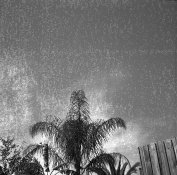Hi,
Would appreciate some opinions about what caused the defects in these negatives (attached photos). A bit of background. I occasionally shoot some test rolls for a camera repairman friend. These negatives came from two different rolls of Ilford FP4 120 film shot on a 6x6 and 6x4.5 camera. Film expiry was 2022 and stored indoors at room temps inside black plastic storage canisters. Developed in Xtol stock (replenished) at standard time and temp I use consistently. I also developed a roll of 35mm TriX at the same time with same developer and it was fine.
Theory: this film was left over from a long overseas trip last year through Scandinavia and Iceland and went through airport hand luggage scanners about 8 or 10 times. However, film developed from same batches when I returned was satisfactory. Does this look like XRay affected negatives? Has anyone seen something similar or suggest a different conclusion about what might has caused this pattern?
Thanks in advance,
Tony
p.s. The strong highlights in shot b are white clouds.




Would appreciate some opinions about what caused the defects in these negatives (attached photos). A bit of background. I occasionally shoot some test rolls for a camera repairman friend. These negatives came from two different rolls of Ilford FP4 120 film shot on a 6x6 and 6x4.5 camera. Film expiry was 2022 and stored indoors at room temps inside black plastic storage canisters. Developed in Xtol stock (replenished) at standard time and temp I use consistently. I also developed a roll of 35mm TriX at the same time with same developer and it was fine.
Theory: this film was left over from a long overseas trip last year through Scandinavia and Iceland and went through airport hand luggage scanners about 8 or 10 times. However, film developed from same batches when I returned was satisfactory. Does this look like XRay affected negatives? Has anyone seen something similar or suggest a different conclusion about what might has caused this pattern?
Thanks in advance,
Tony
p.s. The strong highlights in shot b are white clouds.






